We’re not here to convince you to use a crate for your dog.
Either you use one or you don’t.
Either way is fine.
These are simply our tips on how to make crate training easier for your dog or puppy if that’s the route you want to go.
We use “crate” and “kennel” interchangeably in this article to mean the same thing.
Crate training for puppies
We recommend you start crate training your puppy as soon as you bring her home.
Crates are a wonderful means for keeping your puppy from chewing on or eating inappropriate items such as shoes, kids’ toys, furniture and power cords.
They also make puppy potty training a breeze and provide a safe and cozy area for puppy naps and tucking her in at night.
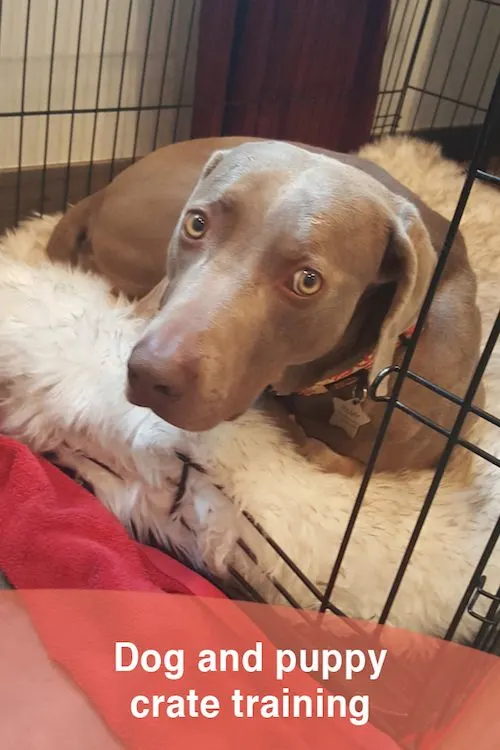
Different types of dog and puppy crates
It comes down to personal preference and lifestyle as to which you’ll want to use. We prefer wire crates because they fold up easily for traveling to visit family, stay at a hotel or go to an agility trial.
Soft dog crates are also a wonderful lightweight option to take along on road trips and easily set up at your dog sports event.
But a soft crate is best for after your dog is kennel trained, of course, so he doesn’t break out.
What to put in your puppy’s crate
- High-valued treats
- Safe puppy chews like Bully Sticks
- Soft rubber chew toys like a KONG
- Stuffed toy (optional)
- A cozy crate mat, blanket or towel
- A crate cover like the ones from Molly Mutt (optional). A blanket or sheet will do the trick too.
- A puppy heartbeat toy (optional idea)
Other crate motivators could be a piece of your clothing with your scent on it such as a t-shirt. If possible, bring a small towel to the breeder or shelter when you pick up your puppy. Place it with the mom and littermates to get their scent on the towel. You can then put that in your puppy’s kennel later.
Playing soothing, soft relaxing background music is another option to make the crate experience a more pleasant one.
There are several YouTube playlists that feature awesome, calming music for dogs.
Calming music for dogs in their crate:
- https://www.youtube.com/watch?v=KNQ-9uEclWA
- https://www.youtube.com/watch?v=UsDEaNavdls
- https://www.youtube.com/watch?v=v8cb2xGAnj0
How to crate train a puppy:
The main benefit of crate training puppies compared to older dogs is how impressionable they are at their young age.
Most puppies will easily adapt to a kennel within a few days, especially if the breeder already introduced them to being crated.
1. Start with a crate appropriate for your puppy’s size.
It needs to be spacious enough for the puppy to comfortably stand and turn around in but small enough so she doesn’t think about using one side as her “potty area.”
Alternatively, use a crate divider if you’re considering using a larger crate. The crate divider can be removed once the puppy grows. It’s a good way of avoiding having to spend money on several different sized crates.
2. Location for the puppy’s crate.
Set the crate up in a centrally located area of your home where your puppy can observe his surroundings and doesn’t feel left out. At night, place your puppy’s crate by your bed for the first few nights.
3. Start with short crating sessions.
Toss high-value treats in the crate for your puppy and give praise when she investigates. No need to close the door quite yet.
Once she is comfortable going in the crate, close the door for a few seconds, then open it up again. Slowly increase to closing the door for 5, 10, 15 seconds.
4. Leave the crate door open with tempting goodies inside.
Place high value treats or toys inside of it. This will motivate the puppy to explore because puppies are curious by nature. Turn the crate into a cozy, fun den your puppy will enjoy being in.
5. Feed your puppy inside of his crate.
Most puppies love their food! This will make him associate good things with being crated.
It’s best to plan 3 specific meal times per day for your puppy vs. leaving food out all the time. That way you can get your puppy on a predictable bathroom schedule and you can use the meals as a reward for going in the crate.
6. When your puppy is sleepy, put her in the crate for a nap.
If your puppy is tired, that is a good time to put her in her crate for a nap. She might fuss for a few minutes but then will most likely fall asleep. Puppies need a lot of sleep! If she is sleeping, don’t bother her for 30 minutes or so. Let her be.
7. Offer regular potty breaks.
Young puppies will only be able to hold it for an hour or so during the day. Make sure to provide plenty of potty breaks to prevent accidents in the kennel.
Many large breed puppies can hold it for 6-7 hours at night, but some might need a potty break in the middle of the night for the first few weeks.
If you got your puppy from a breeder, she can help give you an idea of the best schedule for your specific breed.
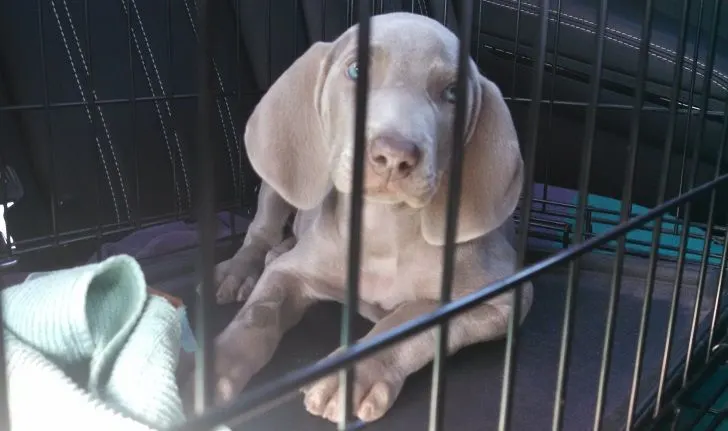
What not to do when crate training puppies:
- Never use the crate as punishment
- Don’t leave your puppy in the crate for too long.
- Don’t give in to your puppy’s initial cries of protest. Instead, take him outside to see if he does indeed have to go potty. But stay focused on the potty job. If he doesn’t go within a few minutes, go back inside and crate him again.
Check out Lindsay’s post How Long Do Puppies Cry At Night? for further reading.
Sample puppy crate training schedule
Most dog and puppy owners don’t work from home and will be gone between 6-9 hours during the day. This means you’ll be crating your dogs while you’re out of the house, at least until she’s gained your trust.
It’s helpful to build a support system to ensure your puppy gets adequate potty and walking breaks if you can’t return home on your lunch break.
This support system could consist of family members, friends, neighbors or a professional dog walker.
Crate training schedule for 8 week old puppy
This is a sample puppy crate training schedule for a puppy 8 weeks old to 4 months old:
We recommend you give your puppy her meals in her crate to help associate awesome things with the crate!
This might seem like a lot of time in the crate, but we are thinking of a person who works full time and may hire a friend or dog walker to stop by mid-day. Also keep in mind young puppies need to sleep a lot more than we realize.
- 6 a.m.: Wake up, potty break, breakfast in the crate, go for a walk
- 7:30 to 9:30 a.m.: Crate time
- 9:30 a.m.: Walk with dog walker
- 10 to 12:30: Crate time
- 12:30 to 1 p.m.: Walk on your lunch break
- 1 to 2:30 p.m.: Crate time
- 2:30 to 3 p.m.: Walk with dog walker
- 3 to 5 p.m.: Crate time
- 5 p.m.: Walk or play when you get home
- 6 to 10 p.m.: Dinner in crate and then hang out all evening (potty breaks as needed)
- 10 p.m.: Final potty break and back in crate for the night
Most puppies will not need a potty break in the middle of the night once they are 9-10 weeks old but each puppy is different. Take your puppy out at 2 a.m. if you know she needs it.
If you work from home or are home during the day, you can probably have your puppy out of the kennel a lot more!
You should still plan a few structured times a day for your puppy to stay in her kennel, even while you are home. This helps the puppy learn to be calm and not to depend on you for constant interaction.
For example, crate time could be from 9:30 a.m. to 11:30 a.m. and from 2:30 to 4:30 p.m.
Older puppy crate training schedule
Puppies ages 4 to 6 months should be able to go with 1 to 2 potty breaks less and also shouldn’t need the potty break in the middle of the night. The same schedule applies to adult dogs:
- 6 a.m.: Wake up, potty break, breakfast in the crate, go for a walk
- 7:30 to noon: Crate time
- Noon: Potty break/walk
- 12:30 to 5 p.m.: Crate time
- 5 p.m.: Walk
- 6 to 10 p.m.: Dinner in crate and then hang out all evening
- 10 p.m.: Potty break and bed time
At a certain age, you can begin leaving your dog out of the crate at night or for short periods while you are away. That age all depends on your specific puppy or dog.
With Lindsay’s sporting breeds, it was best to kennel them until they were about 18 months old. Then, she started leaving them loose for short periods during the day.
As they were successful, she increased that freedom. If they chewed something, then she knew to decrease their freedom for a few more months while they matured.
Our ultimate goal is to not need the crate at all but to have a dog that accepts the crate when needed for travel, vet visits, grooming, etc.
What to do about a puppy crying in the kennel
This is stressful, we get it!
Usually the best thing to do is ignore your puppy. If you know she has to go potty, then calmly take her outside (no playtime) and give her a chance to go. Whether or not she goes, put her right back in the crate.
For more details on what to do about crying, refer back to our detailed article on how long puppies cry at night.
Good luck and hang in there!
How to train an adult dog to use a crate for the first time
It will likely take older dogs longer to get used to being crated if they never experienced it before.
That’s why it’s important to be patient with your older dog and to practice crate training consistently.
It’s also important not to feel bad for your dog when you’re getting ready to crate him or leave the house for a little while. Dogs pick up on our energy and reflect it, so if we’re stressed out and anxious about leaving, so will they.
Set up the crate in an area of your home that’s not a crazy high traffic area, but where your dog can still observe what’s going on.
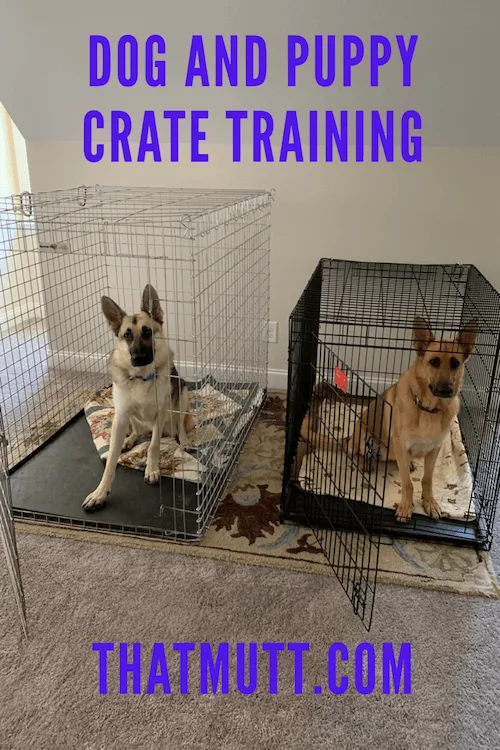
You should follow similar steps that we already outlined for crate training a puppy.
For example, leave the crate door open at first and make the interior interesting to your dog by turning it into a comfy hangout spot equipped with a soft blanket or crate mat, a favorite chew toy and high value treats.
Praise him warmly as soon as he shows any interest in the crate, and especially when he decides to walk in there on his own.
Start with short crate training sessions
Start with very short crating sessions when you’re home, i.e. 20-30 seconds and slowly work your way up to a few minutes at a time.
You can start by just turning your back to your dog while he’s crated for a few minutes, and then slowly progress from there by walking into another room, and then briefly out of the house, maybe to get the mail or just stand outside the front door for a few minutes.
It’s important not to make a big deal out of coming back inside and back into your dog’s field of vision. If you stay calm, your dog will have an easier time staying calm too.
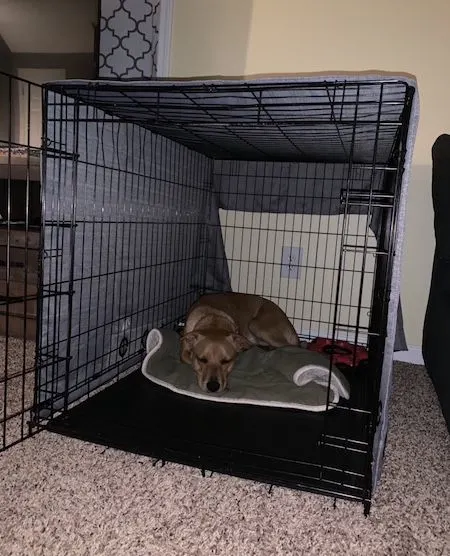
Obviously the crate is not meant to be used to keep your dog confined all day long.
Your dog will need regular potty and walking breaks, and should only be in his crate for 4-5 hours tops at a time during the day.
Crate training older dogs – an example
One of Barbara’s pet sitting clients is an older Beagle named Maggie.
Miss Maggie was never crate trained as a puppy or younger dog and lived alone with her male owner. All was well until her “dad” had a woman enter the picture. Now this woman started sleeping over and Maggie was no longer allowed to sleep in the bed at night.
The couple decided to start crating Maggie at night to keep her from jumping on their bed. They understandably did not want Maggie in bed with them. If you want your dog on your bed, that is fine. But if you do not want your dog on your bed, that is also fine.
Well, Maggie’s initial response to the change was strong protest in the form of quite annoying beagle howls for hours!
But, she ended up accepting the crate because it got turned into a cozy hangout spot.
Her crate features a comfy blanket or soft towel. She has a dog food puzzle in there that gets filled with treats, and she eats both breakfast and dinner in her crate.
Her meals are served with the crate door open, and were the gateway to making the crate a more pleasant experience for her. Her love of food made her walk into the crate on her own once her meals were placed in there.
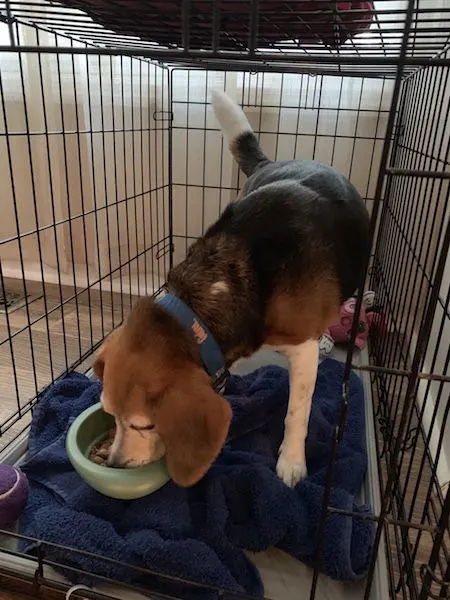
She just needed a little light bulb moment to help her realize that the crate wasn’t as bad of a place as she originally interpreted it to be.
Her owners also sprinkle a calming herbal powder onto her meals and use an essential oil diffuser in the living room area where Maggie’s crate is located.
Kennel training if your dog is not food motivated
Not all dogs are food motivated, and that’s usually because they aren’t presented with food they perceive to be of high value.
If your dog doesn’t respond well to dry kibble or a dry treat, try offering him a super high value treat, ideally one that smells a little, such as fish treats or green tripe treats!
We have never encountered dogs who didn’t go for those, so give them a try!
You could turn treat time into a nose game by putting the treats into a dog food puzzle, like a hollow KONG toy.
We recommend the following high-value treats:
- Vital Essentials freeze-dried Minnows (fishy treats that don’t smell terribly to our human nose, but they’re still plenty fishy for our dogs!)
- Raw Paws Pet Food freeze-dried Green Tripe
- Real Dog single-ingredient air-dried treats from their subscription box (not too smelly, features hearts, spleen, liver, gizzards, etc.)
Taking your dog for a walk and/or having a playtime session with her before crating her will also contribute to her being more willing of being confined to a crate.
An exhausted, tired dog typically just wants to settle down for a relaxing nap, so it’s important to provide an outlet for her energy before expecting her to spend time in her crate.
Here’s a recap of what to keep in mind when crate training your older dog:
- Be patient & consistent
- Use high value treats as a crate motivator
- Use food puzzles to hold the treats/food and for mental stimulation
- Exercise your dog before crating him, even if it’s only a slow walk around your neighborhood with your old pal
- Equip the crate with a piece of your clothing that has your scent on it, like a tshirt
- Make the crate a cozy hangout spot by adding a soft blanket or crate mat
- Play soothing background music while your dog is crated
- Limit his crate time to 4-5 hours at a time
How to stop a dog from barking in his crate
There are a few reasons why a dog might be crying or barking in his crate, and it’s important to understand them in order to prevent crying in the first place.
Reasons a dog barks in his kennel
- Boredom
- Separation anxiety
- Noise related anxiety or fear
- A learned behavior/habit
- Lack of training and socialization
We’ll expand on some of these ideas below.
Exercise your dog a lot while crate training
We always recommend to thoroughly exercise your dog before crating him because a well exercised dog is a calmer dog.
You can easily achieve this by adding a doggie backpack to your exercise sessions along with practicing basic obedience commands.
Also see our post: Exercise ideas for dogs
Along with a lot of exercise before crating your dog, make sure your dog has an appropriate outlet for bursts of energy while in his crate.
These outlets can be a favorite chew toy or a filled dog food puzzle. You can either fill it with high value treats or his food. We recommend freezing it overnight for longer lasting entertainment. This option serves double duty as pain relief for teething puppies.
It’s also helpful to create a soothing environment that will help your dog relax while he’s crated. This could mean covering his crate with a crate cover or similar fabric and playing soft music in the background.
Observe your dog when he starts barking in his crate and analyze the situation.
What sets him off?
Distractions outside of the crate
Distractions outside a window
Does his crate face a window that gives him visual access to construction or people and other dogs walking by?
Try positioning the crate elsewhere without a visual of the outdoors, or consider closing window treatments such as blinds or curtains.
Then work with him on exposing him to a variety of situations outdoors with the goal of no longer being startled by them.
Start by walking past construction areas or other people and dogs at a safe distance and reward calm behavior with warm praise, a gentle pat on his body or high value food rewards. Slowly decrease the distance you keep between yourselves and the distractions as your dog learns to remain calm.
Does he start crying when you walk into the room and start giving him attention?
If that’s the case, completely ignore your dog while he’s acting up and only give him attention when he quiets down, even for just a few seconds. It’ll teach him that silence is golden.
Does he cry because he’s asking to go potty?
Start giving him regular potty breaks while he’s crated. If you can’t personally provide those breaks, you’ll have to implement a support system to do it for you. This could be a friend, a family member, or a professional dog walker.
If his crying for potty breaks remains consistent even when offered regular breaks, rule out a potential medical concern such as a UTI by taking him to your vet for an exam.
Or maybe he cries during a thunderstorm?
Work with him on noise related phobias by slowly exposing him to loud noises and rewarding calm behavior with warm praise and high value food rewards.
You can find a plethora of sounds on YouTube for this purpose. Start with very short sound sessions and slowly increase their length and volume. You could also try wrapping your dog in a thundershirt or simply a tshirt until he’s made progress.
Separation anxiety in dogs
Dog separation anxiety is when a dog is truly anxious or fearful of being alone or separated from her human or dog family. When a dog has separation anxiety and whines in the crate, it can seem like the dog is afraid of the crate but really the issue is being alone.
We have written several posts on separation anxiety so we won’t get into those details here. You can see the following posts for more info:
Also see our post: How to stop your dog from barking in the morning
Is it cruel to crate train an adult dog?
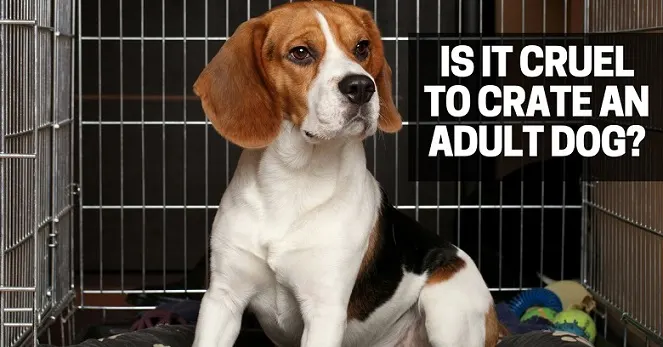
No, it’s not cruel to crate train an adult dog.
In general, it’s completely fine if you want to leave your well-behaved adult dog in a crate when you’re not home.
But of course, it depends on the dog.
Using a crate is helpful for some adult dogs for these reasons:
1. Some dogs appreciate the crate routine when they’re home alone. It’s what they’re used to. It helps them feel calm and secure. They become anxious without the crate.
2. Some dogs will always get into things on occasion such as the trash or food on the counter or whatever it might be. Crating removes those opportunities.
3. Some dogs bark out the windows or scratch at the doors and windows. Crating them removes those opportunities.
4. The majority of dogs sleep the whole time their owners are gone. It’s simply not a big deal to crate them.
5. If you have multiple dogs, sometimes it’s safer to crate one or both while you’re away to prevent fights or mischief.
6. Some people have enough stress in their day with work or kids or whatever. Crating the dog removes the added stress of worrying about the dog. Totally worth it.
7. Most dogs don’t really mind their crates if they’ve been crate trained. They adapt to whatever we decide for them.
The crate is a tool to help a dog earn future freedom.
Lindsay had a senior Lab mix named Ace and a weimaraner named Remy. When she would leave them home alone together, Ace was always allowed to be loose while Remy was crated.
Ace had earned his privileges. Remy had not!
She used a kennel with Ace until he was about 18 months old. The kennel helped him learn the proper routine of relaxing when home alone vs. getting into things.
Remy took a little longer, but once he turned about 3 years old, he could also be trusted without a kennel. Each dog is an individual and Remy pushed the limits more than Ace did.
Now we’d like to hear from you!
Is your dog or puppy crate trained? How did you get your dog or puppy used to the crate?
If you have any questions, let us know in the comments!
Barbara Rivers writes regularly for That Mutt. She is a blogger, raw feeder and dog walker and maintains the blog K9s Over Coffee.
Lindsay Stordahl is the founder of That Mutt. She writes about dog training and behavior, healthy raw food for pets and running with dogs.

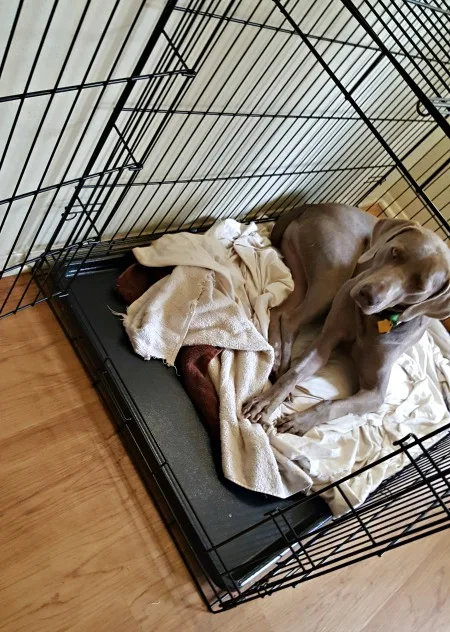
Lindsay Stordahl
Thursday 5th of December 2019
Glad you liked the post!
anthony
Tuesday 3rd of September 2019
WOW!!! Amazing post! Really covers crate training from A-Z!!!
Barbara Rivers
Thursday 5th of September 2019
We're glad you enjoyed it, Anthony :)